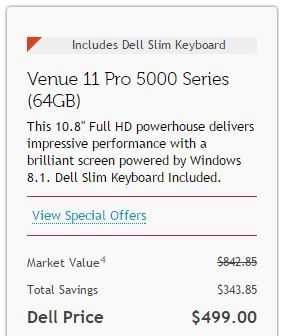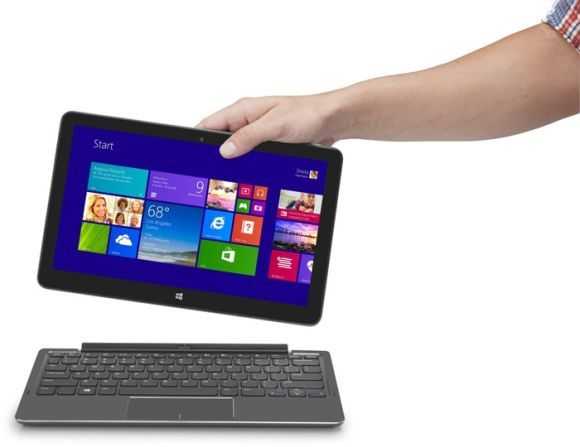An updated Dell Venue 11 Pro 5150 (5130 in some areas) with a high-end Atom CPU, 64 Bit Windows and Full HD screen has appeared. This is the closest I’ve seen to the Microsoft Surface 3.
The high-end Atom CPU is the Z3795 which has Turbo Boost to 2.4 Ghz, just as the Surface 3 does and seeing as the Atom X7 and Z3000 series have similar per-clock CPU power there shouldn’t be much difference in CPU-related benchmarks (<10% based on reports so far.) The X7 will probably pull clear with GPU benchmarks. SSD speeds will be close and there’s even a USB 3.0 port on the Dell. That’s rare for products based on the Z3000-series.
64-bit Windows is important because it means the 64-bit bootloader is far more compatible with alternative Linux builds than the Z3xxx series products that only have 32-bit Windows bootloaders. It’s available, with a slim keyboard, for $499 in the USA – the price of the Surface 3 tablet, without keyboard. There’s a similar product available in Europe which also works out cheaper than the Surface 3.Consider the following before ordering the Dell Venue 11 Pro 5150. Firstly I have requested a review sample of this product (and the Surface 3) so i’ll be able to update you on all the performance figures and answer questions with authority soon. In the meantime, consider the following:
- 10.8 inch screen on Dell is the same ‘size’ as the Surface 3 but the Surface 3 is a 3:2 ratio screen with 1920 x 1280 resolution. 200 more pixels in the vertical (landscape mode.)
- Keyboard options on the Dell mean you can get a power-keyboard that is lap-able and includes an extra battery (for about 50% more battery life.) The keyboard weighs as much as the tablet though. The Slim Keyboard option has a fixed angle and no backlight. It weighs 11 ounces taking the total weight of the product to about 2.2 pounds / 1 KG.
- A docking station option is available for both. A folio case is also available for the Dell.
- The stylus option for the Dell is cheaper than the stylus option for the Surface 3 but I can’t comment on pen performance as I haven’t tested the Dell stylus.
- The Dell Venue 11 Pro 5000 has HDMI video output. The Surface 3 uses the DisplayPort standard, which is arguably better for multiple displays (Chaining.)
- At 1.57 pounds 770 grams the Dell Venue 11 Pro 5000 tablet is much heavier than the Surface 3 and this could be the most important difference between the two. The Surface 3 tablet weighs just 1.37 pounds / 622 grams. You will notice this difference a lot when holding the tablet for long periods.
- The Dell Venue 11 Pro 5000 does not include a year of Office 365 / 1TB storage upload. The Surface 3 does.
- No AC Wifi on the Dell. AC Wifi on the Surface 3.
- Screen quality on the Dell 5130 was reported to be good. It should compete with the good screen quality on the Surface 3.
- The Dell has an NFC sensor. (The Surface 3 doesn’t.)
- Graphics performance on the Surface 3 will beat the Dell by an estimated 30-50%.
- The (removable) battery on the Dell is bigger than that in the Surface 3. (32 Wh vs 27 Wh) This explains a lot of the thickness and weight difference.
- LTE options available on both Venue and Surface. (Location dependant.)
- Micro SD card slot on Dell requires a pin to open. (It’s meant to be tidier and slightly more secure.)
Update: A summary comparison, including some benchmarks, is available Dell Venue 11 Pro vs Surface 3 comparison.
The difference between the Surface 3 and the Venue 11 Pro 5000 is minimal. I like that there are 2 keyboard options on the Dell and at this point I lean towards the Dell as the better option. But that’s me, what are your thoughts? 3:2 vs 16:9 is a big discussion as is the tablet weight.
My colleagues at Notebookcheck have a full review of an older Dell Venue 11 Pro 5130 here and they are working on a Surface 3 review here (currently in German.)














What are the dimensions of the devices? The comparison link doesn’t seem to be working.
How does keeping the devices updated compare? I’m leaning towards the Surface hoping that it’s a one click (or a few) thing to keep the OS, drivers and firmware updated. Is my assumption true? This is important to me because easily keeping everything updated is a major security feature to me. Drivers and firmware can have security issues as well as the OS but OEMs tend to not provide updates or make it a pain to update.
Also, any info when LTE versions will be released? I’m waiting on those.
Corrected link.
http://www.umpcportal.com/dell-venue-11-pro-atom-vs-microsoft-surface-3/
Thanks for the heads-up.
Chippy.
Why don’t more OEMs go for 3:2 or 4:3 aspect ratio on tablets of this size? Everyone seem to be unanimously on the side of that aspect ratio compared to 16:9 for browsing and productivity, which is what this form factor is all about!
As for your comparison, I think Microsoft wins out because of its weight, aspect ratio and build quality, although the Surface 3 does seem to have its problems (battery and emmc speed).
Here’s to hoping that someone releases a core M, 3:2 tablet with full SSD and reliable battery.. Oh, and great build quality. Too much to ask?
the main difference for me is that the pen on the Dell is the same Synaptics piece of junk they pushed on their Venue 8 Pro which was terrible. The pen alone would have me steer clear of the Dell. I had the Venue 8 Pro and the pen was terrible. HDMI won’t handle the higher monitor resolutions that the mini displayport will on the Surface 3.
I currently own a Dell 5130 and there are a couple issues with the the previous generation of Dell Venue 11 Pro tablets that dell has been stringing people along for a non existent fix since they released them… when the new ones were announced they finally reported on the forums that no fix would be forthcoming… buy or new version.
Don’t get me wrong the 5130 is an excellent lil machine. But there are a couple gotchas that do NOT show up in any of the reviews ive read. They all involve the slim keyboard and the reality of its implementation versus user expectations.
It comes down to this, the slim keyboard is essentially a USB keyboard thats ‘plugged in’ whenever the slim keyboard is attached. Windows 8 disables screen rotation when there is a USB keyboard attached… so you can’t for use the tablets as a notebook in landscape… pick it up and fold the keyboard back behind it and use it as a portrait tablet… the screen won’t rotate.
You can get around the first one by rotating the screen manually but thats a pain and leads to the next problem… when your using the tablet in portrait as a tablet with the slim keyboard folded back behind it windows 8 still sees a keyboard attached so it won’t display the on screen keyboard in the modern interface when you tap in a text box.
Both of these examples are behaviors that every surface commercial has imprinted in peoples heads that they should be able to do with their tablets without a second thought. And yet, dells official response in their forums about it was… no one thought of those usage patterns so it wasn’t acccounted for in our design, we are looking into a software resolution…. following by ‘our techs are working on it’ for the next 18 months and finally… we have a new one out, buy it… not sure if its fixed there or not but it might be and we could really use more of your money.